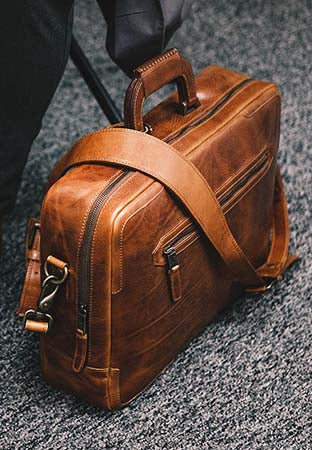Handcrafted leather is built to stand the test of time. Large pieces - leather couches, chairs, and bags - become family heirlooms that last generations. Smaller pieces - wallets, watch bands, shoes - become our go-to accessories or remind us of the loved ones that gifted them to us.
All leather pieces are living things. They require not only care and maintenance, but also, occasionally, fixing and spot treatment. Whichever leather piece you cherish, we at Will Leather Goods want to help you make it last a lifetime. We’ll start with some basic leather knowledge that applies to most leather goods, then branch out to several specific product categories. If your question isn’t answered here, reach out to our leather care experts and we’ll help you figure out how best to take care of your piece.
How To Clean Leather - From the Experts
How To Care For Fine Leather
Handcrafted leather is built to stand the test of time. Large pieces—leather couches, chairs, and bags—become family heirlooms that last generations. Smaller pieces—wallets, watch bands, shoes—become our go-to accessories and remind us of the loved ones who gifted them to us.
All leather pieces are living things. They require not only care and maintenance, but also occasional fixing and spot treatment. Whichever leather piece you cherish, at Will Leather Goods we want to help you have yours last a lifetime—from basic leather knowledge, that applies to most leather goods, to specific product categories.
If your questions aren’t answered here, reach out to our leather care experts and we’ll happily help you figure out how best to take care of your piece.
BASIC LEATHER MAINTENANCE
Finished leather requires a set of basic steps to ensure its longevity, regardless of whether it is top grain, split, or bonded leather. This applies to leather derived from any animal hide.
Unfinished leather (also known as aniline or nubuck) doesn’t undergo all of the same processes as traditional finished leather. Most notably, it lacks a top “seal”. This means it is particularly vulnerable to absorbing any liquid it comes in contact with, thus the following care steps would not necessarily be applied to unfinished leather.
CONDITIONING
Leather conditioning essentially returns moisture to the material. This moisture helps the leather fibers remain pliable, which in turns keeps the piece feeling soft and supple. We recommend that you condition your leather pieces twice per year, about every six months. If you live in a particularly dry climate, you may find that you’ll need to condition your leather more frequently. A good rule of thumb is that when the leather starts to feel less supple, dull, or faded, it’s time to condition.
Important note: Make sure to spot test a new conditioner (or an old conditioner on a new product) in an inconspicuous location. Some leathers, more than others, are particularity susceptible to absorbing moisture and oils. You’ll want to see how your piece and a conditioner interact.
Follow these guidelines to condition your leather pieces:
- In addition to water spotting and soiling, leather is susceptible to absorbing grease and oil -- ALWAYS HANDLE WITH CLEAN HANDS. Apply a leather conditioner made specifically for the leather needing maintenance. We recommend our All-In-One Leather Solution.
- Using a soft cotton cloth, apply approximately 1 oz. of the solution over the entire surface of the leather.
- Allow the application to dry on the leather for at least 12 hours, away from sunlight and heat.
- When dry, buff the leather with a soft cotton cloth, using a circular motion.
- Repeat every 6 months or as needed to clean, condition and protect your leather goods.
And that’s it! The process is simple -- the diligence is the hardest part. However, staying on top of conditioning your leather gives it beauty that lasts a lifetime.
CLEANING SPOTS AND SCRATCHES
Like anything else, leather gets dirty! While most leather products are fairly resistant to dirt, dust, and grime, they still require cleaning (in addition to regular maintenance and care) from time to time.
Mild Spots are the most common, and, thankfully, the easiest to clean. For most dirt and dust on your leather, simply wipe down with mild soapy water, using gentle circular motions on the spot, rinse soap with a clean cloth. Take care not to soak the leather or leave a damp cloth on the piece for an extended period of time. Dry thoroughly.
Tougher Spots are inevitable—something will be spilled on your leather bag, or oils will get on your leather wallet. Don’t fret, leather is tough! There are a few steps that you’ll need to follow as soon as possible to have the best chance of removing spots from your leather. The longer the stain is allowed to set, the more likely the oils will seep deeper into the leather.
- Use a baby wipe to clean the spot. Avoid alcohols and solvents as these can discolor the leather.
- Holding your hand behind the leather, apply pressure to the stain and dab in a circular pattern on and around the stain. Don’t push too hard, doing so can discolor the leather.
- Allow the piece and surrounding area to dry completely before using or storing.
HOW TO REMOVE SCRATCHES FROM LEATHER
As leather ages, it is bound to gain a few scratches and dents. This is part of the character of leather. These blemishes show your leather’s journey. When you want to remove particular scratches, follow these steps to help work them out
- Locate the scratch or spot on the leather goods.
- Using the oils from your hands, bend and work the spot back and forth over the scratch and marks.
- Continue as needed, working the leather. The scratch will continue to disappear over time.
- Maintain as always.
STORING YOUR LEATHER
In order for your leather goods to look great when you’re using them, they need to be stored properly when you’re not. There are two timeframes for storage: short-term and long-term.
Short-Term Storage—less than a month—watches, purses, totes, bags. These are items used frequently, not sitting in a closet for an entire season.
- Keep your leather goods out of the sun. Hanging a leather bag on a coat rack in your foyer may be a good idea—but only if there isn’t a window through which direct sunlight can shine on it. While these items are meant to be out in the world, and the sun, adding five hours of sun exposure every day for years can shorten the lifespan of your leather.
- Keep your leather goods in a dry place. This includes avoiding short-term storage near humid areas, such as kitchens and laundry or bathrooms.
- Use a proper hanger. When left to hang, even the best leather can develop creases. For example, leather jackets should be kept on proper wood or padded hangers as opposed to thin wire hangers.
Long-Term Storage. Seasonal leather goods, such as heavy jackets and certain bags typically get put away for summer. These should only be stored in breathable bags or containers.











